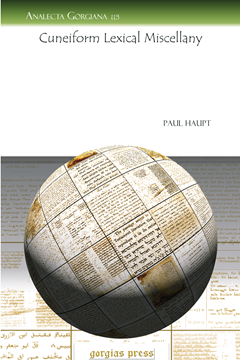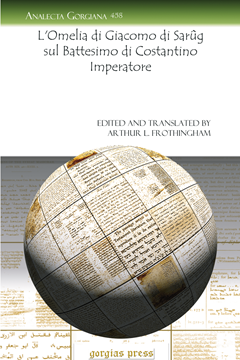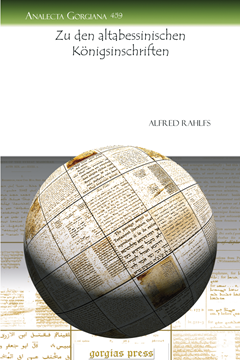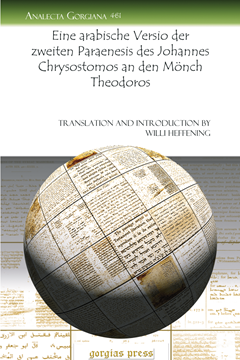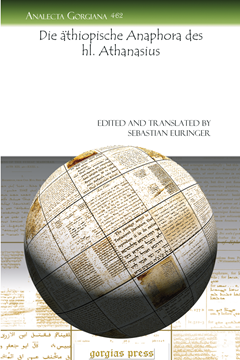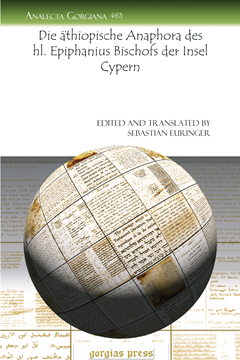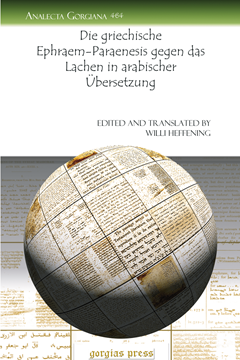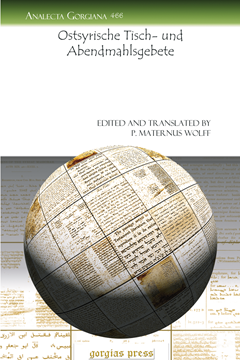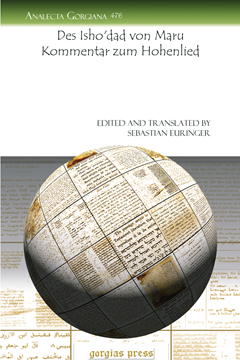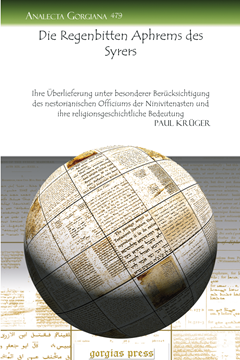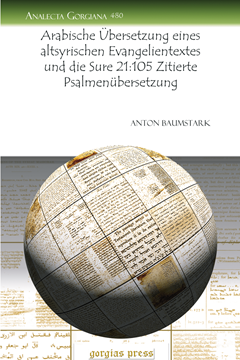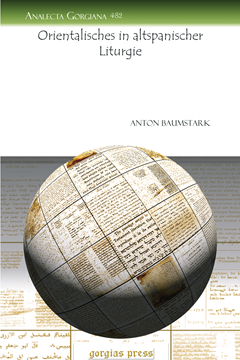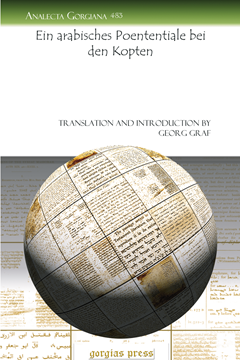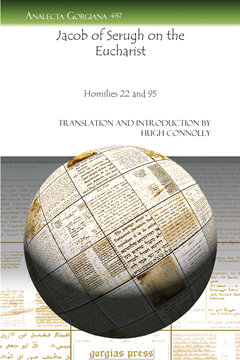Analecta Gorgiana
Analecta Gorgiana is a collection of long essays and short monographs which are consistently cited by modern scholars but previously difficult to find because of their original appearance in obscure publications. Carefully selected by a team of scholars based on their relevance to modern scholarship, these essays can now be fully utilized by scholars and proudly owned by libraries.
Cuneiform Lexical Miscellany
By Paul Haupt
Series: Analecta Gorgiana 115
ISBN: 978-1-60724-047-1
The cuneiform terms for sport introduce these studies on a variety of topics dealing with Akkadian and Sumerian lexicography. Other essays include an exploration of a cuneiform description of a volcanic eruption, the Assyrian words pâtu (blowy), pâţu (brim), miţpânu (longbow), talîmu (full brother), budulxu (bdellium), zâzu (halve), marçu (sick and arduous), xamâdu (to help), napšu (lust), and kamâsu, kanâšu, and qamâçu. Semitic and Classical descriptions of naphtha and asphalt, and a study of the cuneiform name of the home of ‘Omar Khayyâm are included. Sumerian lexicography is not neglected, with explorations of nimur (salt, smoke, salt-swamp), and azalak (fuller).
$48.00 (USD) $28.80 (USD)
Social Aspects of Christianity
Series: Analecta Gorgiana 199
ISBN: 978-1-60724-301-4
In this influential book, Ely produced an impact outside his own field of economy that was felt in the world of theological study. Still timely and sensible, this treatment of a layman’s view of the social obligations of Christianity maintains its ability to challenge convention and urge for progress. A significant treatment of an essential aspect of ethical religious principles, this book would be profitably read by all who are interested in a fair society.
$70.00 (USD) $42.00 (USD)
Sindban, oder die sieben weisen Meister
Syrisch und Deutsch
Edited and Translated by Friedrich Baethgen
Series: Analecta Gorgiana 456
ISBN: 978-1-60724-894-1
This volume is Baethgen’s dissertation from the University of Leipzig, in which he presents the Syriac text, based on the only manuscript of the work (from Berlin), along with an annotated German translation and an introduction.
$45.00 (USD) $27.00 (USD)
De dialectorum linguae Syriacae reliquiis
Evidence for Syriac Dialects
By F. Larsow
Series: Analecta Gorgiana 457
ISBN: 978-1-60724-895-8
In this brief work, Larsow discusses the evidence for Syriac dialects, other than the well-known eastern and western varieties, and he especially makes use of material from the lexica of Bar Ali and Bar Bahlul.
$37.00 (USD) $22.20 (USD)
L'Omelia di Giacomo di Sarûg sul Battesimo di Costantino Imperatore
Edited and Translated by Arthur L. Frothingham
Series: Analecta Gorgiana 458
ISBN: 978-1-60724-896-5
Frothingham here offers the Syriac text, with an annotated Italian translation, of Jacob of Sarug’s homily on the Baptism of Constantine (832 lines), based chiefly two manuscripts, one from the Vatican and the other from the British Museum.
$51.00 (USD) $30.60 (USD)
Zu den altabessinischen Königsinschriften
Series: Analecta Gorgiana 459
ISBN: 978-1-60724-912-2
Alfred Rahlfs provides translations and a comparative analysis of inscriptions from Ezana, king of Aksum and the Abyssinian Empire that have previously been regarded as proof of the origin of Christianity in Ethiopia.
$38.00 (USD) $22.80 (USD)
Die evangelischen Fragen und Lösungen des Eusebius in jakobitischer Überlieferung und deren nestoria
Edited and Translated by Gerhard Beyer
Series: Analecta Gorgiana 460
ISBN: 978-1-60724-913-9
Gerhard Beyer surveys the evidence for the transmission of Eusebius’s work including questions and answers on the Gospels (peri diaphonias euangelion) within the Jacobite and the Nestorian Syriac traditions.
$49.00 (USD) $29.40 (USD)
Eine arabische Versio der zweiten Paraenesis des Johannes Chrysostomos an den Mönch Theodoros
Translation and Introduction by Willi Heffening
Series: Analecta Gorgiana 461
ISBN: 978-1-60724-914-6
In the present study, Willi Heffening presents a German translation of two sermons by Chrysostom on the subject of the monk Theodore preserved in Arabic. The text is also extant in Greek, but the Arabic version contains several unique features.
$37.00 (USD) $22.20 (USD)
Die äthiopische Anaphora des hl. Athanasius
Edited and Translated by Sebastian Euringer
Series: Analecta Gorgiana 462
ISBN: 978-1-60724-915-3
In the present article, Sebastian Euringer publishes the Ethiopic text of an anaphora attributed to Athanasius. Euringer also provides a German translation of the text as well as a critical apparatus with variant readings and critical notes.
$43.00 (USD) $25.80 (USD)
Die äthiopische Anaphora des hl. Epiphanius Bischofs der Insel Cypern
Edited and Translated by Sebastian Euringer
Series: Analecta Gorgiana 463
ISBN: 978-1-60724-916-0
In the present article, Sebastian Euringer publishes the Ethiopic text of an anaphora attributed to Ephphanius, the Bishop of Cyprus, and accompanies the text with a German translation and a textual apparatus including variant readings.
$41.00 (USD) $24.60 (USD)
Die griechische Ephraem-Paraenesis gegen das Lachen in arabischer Übersetzung
Edited and Translated by Willi Heffening
Series: Analecta Gorgiana 464
ISBN: 978-1-60724-917-7
Willi Heffening publishes here the Arabic version of the “sermon against laughter” attributed to Ephrem. Heffening accompanies the Arabic text with a brief introduction, a German translation, and a critical apparatus with variants from the Greek version.
$37.00 (USD) $22.20 (USD)
Die Chronik des Eusebius in der syrischen Überlieferung
Series: Analecta Gorgiana 465
ISBN: 978-1-60724-918-4
In the present study, Paul Keseling surveys the use of the Chronicle of Eusebius in later Syriac historical works, such as the “Epitome of Syria” and the chronicles of Pseudo-Dionysius, Elias of Nisibis and Michael the Great.
$46.00 (USD) $27.60 (USD)
Ostsyrische Tisch- und Abendmahlsgebete
Edited and Translated by P. Maternus Wolff
Series: Analecta Gorgiana 466
ISBN: 978-1-60724-919-1
P. Maternus Wolff publishes here the text and German translation of twenty Eucharistic prayers from the Syraic tradition. Wolff also includes an apparatus containing critical notes and an introduction in which he discusses several unique features of these prayers.
$36.00 (USD) $21.60 (USD)
Des Isho'dad von Maru Kommentar zum Hohenlied
Edited and Translated by Sebastian Euringer
Series: Analecta Gorgiana 476
ISBN: 978-1-60724-944-3
Sebastian Euringer publishes here the Syriac text of Isho’dad of Merv’s commentary on the Song of Songs accompanied by an introduction, a German translation of the commentary, notes on the translation, and parallels from other commentaries.
$36.00 (USD) $21.60 (USD)
Die zwölf Marka-Hymnen aus dem "Defter" der samaritanischen Liturgie
Translation and Introduction by Paul Kahle
Series: Analecta Gorgiana 477
ISBN: 978-1-60724-945-0
Paul Kahle publishes here a German translation, with critical notations, of twelve Aramaic Marka hymns, which are an important piece in the early Samaritan liturgy. Kahle’s work supplements other works that contain the Aramaic texts by providing a modern translation.
$37.00 (USD) $22.20 (USD)
Die äthiopische Überlieferung der Abhandlung des Evagrius "Über die acht Gedanken"
Edited with an Introduction by Otto Spies
Series: Analecta Gorgiana 478
ISBN: 978-1-60724-946-7
Otto Spies publishes here a critical apparatus with variant readings to supplement Johannes Bachmann’s edition of the Ethiopic version of the work “concerning the eight [sinful] thoughts” by Evagrius of Pontus. Spies provides a German translation of the collated text.
$36.00 (USD) $21.60 (USD)
Die Regenbitten Aphrems des Syrers
Ihre Überlieferung unter besonderer Berücksichtigung des nestorianischen Officiums der Ninivitenasten und ihre religionsgeschichtliche Bedeutung
By Paul Krüger
Series: Analecta Gorgiana 479
ISBN: 978-1-60724-947-4
Paul Krüger discusses the influence of the “rain prayer” of Ephrem by tracing its use throughout several stages in the development of the Syriac liturgical traditions.
$43.00 (USD) $25.80 (USD)
105 Zitierte Psalmenübersetzung
Series: Analecta Gorgiana 480
ISBN: 978-1-60724-948-1
The Syriac tradition played an important role in shaping pre- and early Islamic concepts of Christianity. In this article, Anton Baumstark argues that a few Arabic citations of the Bible reflect reliance on Old Syriac translations rather than the Peshitta.
$36.00 (USD) $21.60 (USD)
Eine Homilie des Ampiliochius von Iconium über Basilus von Cäsarea
Translation and Introduction by K.V. Zettersteen
Series: Analecta Gorgiana 481
ISBN: 978-1-60724-949-8
K.V. Zettersteen publishes here a German translation of a homily of which he had previously published separately the Syriac text. The homily is attributed to Amphilochius of Iconium and it serves as a biography of Basil the Great.
$38.00 (USD) $22.80 (USD)
Orientalisches in altspanischer Liturgie
Series: Analecta Gorgiana 482
ISBN: 978-1-60724-950-4
Anton Baumstark compares elements of the “old-Spanish” or Mozarabic liturgy with eastern liturgies in order to demonstrate an “oriental” influence.
$39.00 (USD) $23.40 (USD)
Ein arabisches Poententiale bei den Kopten
Translation and Introduction by Georg Graf
Series: Analecta Gorgiana 483
ISBN: 978-1-60724-951-1
Georg Graf publishes a German translation, accompanied by translation notes, of an Arabic poenitentiale text that is a collection of previous material. Graf also provides an introduction to the text in which he discusses source materials and their relationship.
$36.00 (USD) $21.60 (USD)
Aphrahat's Demonstrations 2 and 7
On Love, and On Penitents
Translated by Frank Hallock
Series: Analecta Gorgiana 484
ISBN: 978-1-60724-952-8
This volume reproduces translations of Aphrahat’s 2nd and 7th Demonstrations into English. The texts cover themes including Law and Gospel, salvation history, commandments to love and forgive, repentance, Jesus as physician, and pastoral care.
$38.00 (USD) $22.80 (USD)
Isaac of Antioch's Homily on the Royal City
Edited and Translated by C. Moss
Series: Analecta Gorgiana 485
ISBN: 978-1-60724-953-5
In this volume, Moss gives an introduction, edition, and annotated translation of an important poem (in the seven-syllable meter) from Isaac of Antioch on the Huns’ attack on Constantinople in the 440s.
$38.00 (USD) $22.80 (USD)
Ueber und aus Reden von zwei syrischen Kirchenvätern über das Leiden Jesu
Translation and Introduction by Pius Zingerle
Series: Analecta Gorgiana 486
ISBN: 978-1-60724-954-2
In these two articles, Zingerle surveys, in German, fourteen poems from Isaac of Antioch and Jacob of Sarug. His aim is to look at how two different Syriac authors expound the same theme: the events surrounding Jesus’ crucifixion.
$41.00 (USD) $24.60 (USD)
Jacob of Serugh on the Eucharist
Homilies 22 and 95
Translation and Introduction by Hugh Connolly
Series: Analecta Gorgiana 487
ISBN: 978-1-60724-955-9
In the two articles reprinted here, Dom Hugh Connolly offers an annotated English translation of two homilies from Jacob of Serugh dealing with the Eucharist (Bedjan nos. 22 and 95), as well as a short selection from homily 53.
$39.00 (USD) $23.40 (USD)

